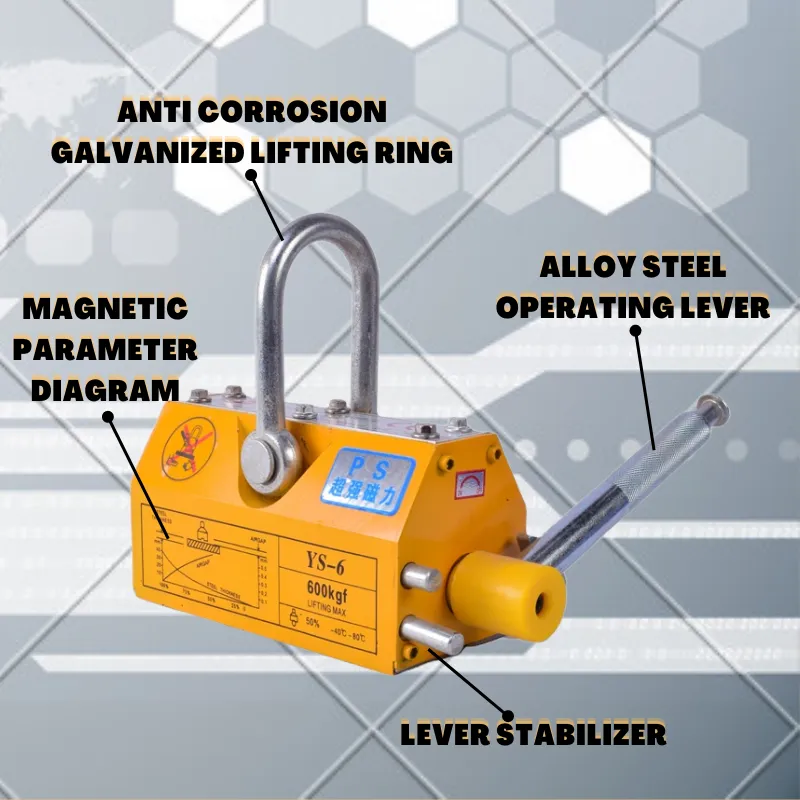Innovative Magnetic Lifting Solutions for Efficient Material Handling and Industry Applications
Magnetic Lifting Systems Revolutionizing Material Handling
In the ever-evolving landscape of industrial equipment and material handling, magnetic lifting systems have emerged as a revolutionary solution. These systems leverage the principles of magnetism to efficiently lift, move, and position heavy ferromagnetic materials, offering significant advantages over traditional lifting methods.
What are Magnetic Lifting Systems?
Magnetic lifting systems utilize powerful magnets to securely attach to and lift metal objects. They are commonly used in warehouses, manufacturing plants, and construction sites for handling items such as steel sheets, rods, and other ferromagnetic materials. These systems can be powered by electric or permanent magnets, allowing for versatile applications across various industries.
Benefits of Magnetic Lifting Systems
One of the primary advantages of magnetic lifting systems is safety. Traditional lifting methods often involve chains, slings, or hooks, which can pose risks of slippage or equipment failure. In contrast, magnetic systems create a strong, reliable grip on the object being lifted, significantly reducing the chances of accidents. This level of safety is crucial in workplaces where heavy lifting is routine.
Efficiency is another significant benefit. Magnetic lifters can dramatically speed up the loading and unloading processes compared to manual lifting methods. They minimize the time required to change attachments and reposition materials, leading to improved productivity. The ergonomic design of many magnetic lifting systems reduces strain on workers, enabling them to transfer heavier loads without additional support.
Moreover, magnetic lifting systems are versatile. They come in various configurations, from small handheld magnets for lighter tasks to large, industrial-grade magnets designed for substantial loads. This adaptability means they can be employed in diverse sectors, including automotive, aerospace, shipbuilding, and construction.
magnetic lifting systems

How Magnetic Lifting Systems Work
Magnetic lifting systems operate on the principle of magnetism, utilizing either permanent magnets or electromagnets. Permanent magnets provide a constant magnetic field, making them suitable for simpler applications where consistent lifting capability is required. On the other hand, electromagnets can be turned on and off, allowing for more control over the lifting process. This feature is particularly beneficial in environments where the lifting and lowering of materials vary frequently.
The design of a magnetic lifter typically includes a lifting plate that comes into contact with the object to be lifted. When activated, the magnet creates a magnetic field that bonds with the ferromagnetic material, securely holding it in place. Operators can easily disengage the magnet when the object needs to be placed.
Applications in Various Industries
Magnetic lifting systems find applications across numerous industries. In manufacturing, they are invaluable for moving steel plates and components during assembly. In the construction sector, they make it easier to position heavy steel beams and frameworks. Additionally, in recycling facilities, magnetic lifters are utilized to separate ferrous metals from other materials efficiently.
Future of Magnetic Lifting Technologies
As industries continue to focus on automation and efficiency, the demand for advanced material handling solutions, including magnetic lifting systems, is likely to grow. Innovations in magnet technology and design, such as the development of stronger, lighter magnets, will further enhance the capabilities of these systems.
In conclusion, magnetic lifting systems offer a safe, efficient, and versatile solution for the challenges of material handling in various industries. As technology advances, these systems will undoubtedly play an increasingly vital role in improving operational efficiency and safety in the workplace. Whether for lifting steel sheets or positioning heavy machinery, magnetic lifting systems are set to transform how industries approach material handling tasks.
-
Unlock Seamless Relocation with Our Heavy Equipment Moving ExpertiseNewsJun.06,2025
-
Unleash Unrivaled Flexibility with Our Adjustable Gantry CraneNewsJun.06,2025
-
Unleash Heavy-Duty Efficiency with Our Industrial Gantry Crane SolutionsNewsJun.06,2025
-
Revolutionize Steel Handling with Our Magnetic Lifter RangeNewsJun.06,2025
-
Master Equipment Mobility with Premium Machinery Mover SolutionsNewsJun.06,2025
-
Elevate Your Material Handling with Magnetic Lifter TechnologyNewsJun.06,2025
-
YS Permanent Lifting Magnets: The Smarter Way to Handle SteelNewsMay.22,2025
